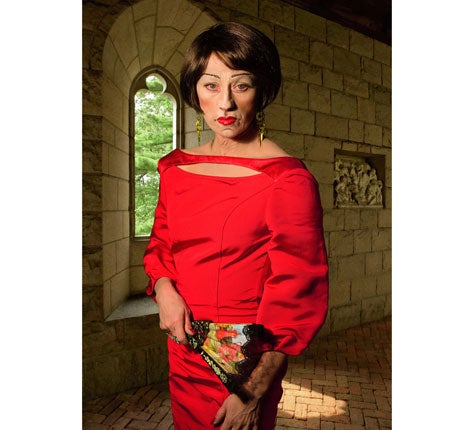Cindy Sherman, Sprüth Magers, London
At first glance, we see New York socialites. But in truth, the artist's been in the dressing-up box again

Your support helps us to tell the story
From reproductive rights to climate change to Big Tech, The Independent is on the ground when the story is developing. Whether it's investigating the financials of Elon Musk's pro-Trump PAC or producing our latest documentary, 'The A Word', which shines a light on the American women fighting for reproductive rights, we know how important it is to parse out the facts from the messaging.
At such a critical moment in US history, we need reporters on the ground. Your donation allows us to keep sending journalists to speak to both sides of the story.
The Independent is trusted by Americans across the entire political spectrum. And unlike many other quality news outlets, we choose not to lock Americans out of our reporting and analysis with paywalls. We believe quality journalism should be available to everyone, paid for by those who can afford it.
Your support makes all the difference.Repellent is, I think, not too strong a word for Cindy Sherman's latest suite of portraits, five of which are on show at her London gallery. (Two are downstairs: you need to ask an assistant to see them.) These depict rich women – society dames of a certain age – shot in large format, typically around 2.5m by 1.75m.
At first glance, everything about these pictures suggests wealth. Their colours are rich, as befits their subjects: deep, saturated, Egglestonian reds and blues. The frames are the gilt-on-gilt ones you might see in a Park Avenue triplex or a Palm Beach palazzo. The images are, as I have said, very big. (How do you print 4sq m photographs?) Above all, though, it is the iconography of Sherman's new portraits that speaks of money, and of the artist's own past as a (lapsed) painter.
Talking about her time as an art student in Buffalo in the Seventies, the 55-year-old photographer has breezily claimed to have realised "there was nothing more to be said [through painting]", and that she should "use a camera to put [her] time into ideas instead". For all that, Sherman's shots still trade on a kind of painterliness, the stiff poses and Her-Majesty-the-Queen gestures of her subjects as instantly recognisable an attribute of big bucks as palms and haloes are of martyrdom.
So far, so Upper East Side. You might see images like these in any American society magazine, portraits of Mrs So-and-So at her gracious Long Island residence. One woman, in a cardigan and too much rouge, hugs herself nervily in front of a grand hotel. Another, in a dress so red that it looks painted rather than photographed, stands in a cloister, a Spanish fan in her hand, a Gothic window and bas-relief behind her. She is particularly scary because she is particularly artificial, and because it is not clear, even so, just where her artificiality lies.
One obvious place is in her identity. Like all of Sherman's series portraits, the sitter for this one was the artist herself. In previous incarnations, Sherman has shot herself dressed up as a clown or as a B-movie actress. Her fascination is clearly with social tribes and subgroups which announce their allegiances through dress and gesture, who signal their identity visually. This in turn prompts a question: why does Sherman like to work in this way?
Her portraits, in not really being portraits, seem to set out to fool us – to convince us that they are representations of other people when they are all of Sherman herself. Given the post-Renaissance belief that portraiture has a duty to reveal hidden truths, this seems particularly heinous. You might see Sherman as having a moral intent: the camera proverbially never lies, but hers does nothing but. In a world increasingly defined by pictures – the millions of images thrown at us daily by television, print media and the internet – it is a useful lesson, although one we have already been taught by, say, the staged street-shots of Jeff Wall. For all their upfront status as art objects de luxe, Sherman's portraits wear their fakery on their sleeve.
Not very close inspection reveals the trappings of her apparent subjects' apparent wealth to be as bogus as their identities, their couture kaftans to have come from jumble sales, their jewellery from charity shops. Fooled you! the portraits say, although in truth they haven't tried very hard to do that.
There is something less theoretical and more visceral at work in Sherman's photographs, though, and it is this that lends them their power. To focus repeatedly, as Sherman does, on signs of inclusion is to portray oneself as serially excluded. One of the worrying things about her portrait series is that it will be split up – that rich dames like the ones she pretends to be here will buy its various pictures and hang them on walls in the Hamptons or East 72nd Street. What, then, will warn us that these are not portraits at all, but lies?
It is the serial untruth of Sherman's own image that tells us what is going on, and that, perhaps, is the scariest thing of all. These are not fake portraits of fake people but one big, multi-portrait of a real person, namely Cindy Sherman. She is the deception at the heart of all her work, the only way she knows, it seems, to portray herself. Whatever else that suggests, it does not suggest great happiness; like the works themselves, rather the opposite.
Sprüth Magers, London W1 (020-7408 1613) to 27 May - www.spruethmagers.com
Join our commenting forum
Join thought-provoking conversations, follow other Independent readers and see their replies
Comments